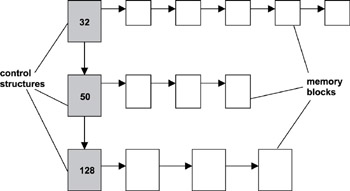Книга: Real-Time Concepts for Embedded Systems
13.3 Fixed-Size Memory Management in Embedded Systems
13.3 Fixed-Size Memory Management in Embedded Systems
Another approach to memory management uses the method of fixed-size memory pools. This approach is commonly found in embedded networking code, such as in embedded protocol stacks implementation.
As shown in Figure 13.6, the available memory space is divided into variously sized memory pools. All blocks of the same memory pool have the same size. In this example, the memory space is divided into three pools of block sizes 32, 50, and 128 respectively. Each memory-pool control structure maintains information such as the block size, total number of blocks, and number of free blocks. In this example, the memory pools are linked together and sorted by size. Finding the smallest size adequate for an allocation requires searching through this link and examining each control structure for the first adequate block size.

Figure 13.6: Management based on memory pools.
A successful allocation results in an entry being removed from the memory pool. A successful deallocation results in an entry being inserted back into the memory pool. The memory pool structure shown in Figure 13.6 is a singly linked list. Therefore, memory allocation and deallocation takes place at the beginning of this list.
This method is not as flexible as the algorithm introduced earlier in 'Dynamic Memory Allocation in Embedded Systems' on page 200 and also has some drawbacks. In real-time embedded systems, a task's memory requirement often depends on its operating environment. This environment can be quite dynamic. This method does not work well for embedded applications that constantly operate in dynamic environments because it is nearly impossible to anticipate the memory block sizes that the task might commonly use. This issue results in increased internal memory fragmentation per allocation. In addition, the number of blocks to allocate for each size is also impossible to predict. In many cases, the memory pools are constructed based on a number of assumptions. The result is that some memory pools are under used or not used at all, while others are overused.
On the other hand, this memory allocation method can actually reduce internal fragmentation and provide high utilization for static embedded applications. These applications are those with predictable environments, a known number of running tasks at the start of application execution, and initially known required memory block sizes.
One advantage of this memory management method is that it is more deterministic than the heap method algorithm. In the heap method, each malloc or free operation can potentially trigger a rearrangement of the heap. In the memory-pool method, memory blocks are taken or are returned from the beginning of the list so the operation takes constant time. The memory pool does not require restructuring.




